You can find goats with coats colored in all the shades of brown: light brown, chocolate, sandy brown, dark brown, and more.
While brown goats are not hard to come by, they are more rare than white and black goats.
So, the odds say you have probably seen a white or black goat, but not a brown one.
Not to worry, if you have not seen a brown goat before, this article will give you an insight into their world.
Below are 11 brown goat breeds.
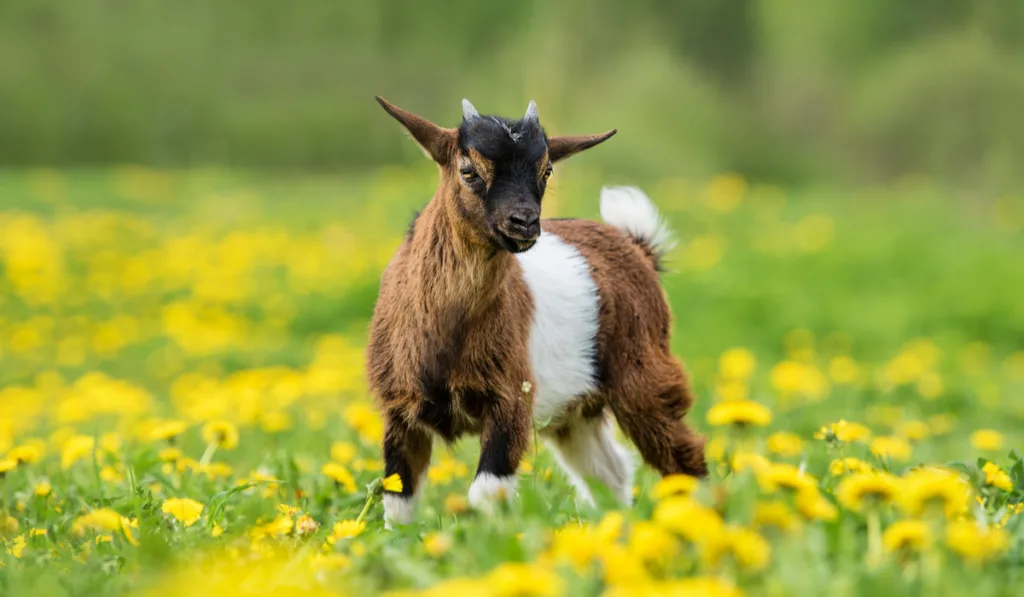
Table of Contents
1. Nigerian Dwarf Goat
Even though they are called Nigerian Dwarf Goats, this breed does not truly originate from Nigeria. They are actually thought to have originated from West Africa.
Nigerian Dwarf Goats have soft coats with short to medium hair, which can come in any pattern or color combination, including brown.
They are typically kept as pets or bred for their milk.
Members of this breed are generally low-maintenance, gentle, and adorable.
At birth, they weigh an average of 2 pounds but they grow pretty fast and are expected to reach an ideal weight of 75 pounds when they reach full maturity.
Nigerian Dwarf Goats can attain sexual maturity within 7 weeks.
However, they may not be used for breeding until they are 7-8 months. In some cases, the bucks may be used for servicing as early as 3 months.
Nigerian Dwarf Goats breed year-round, and in general, the does are good mothers.
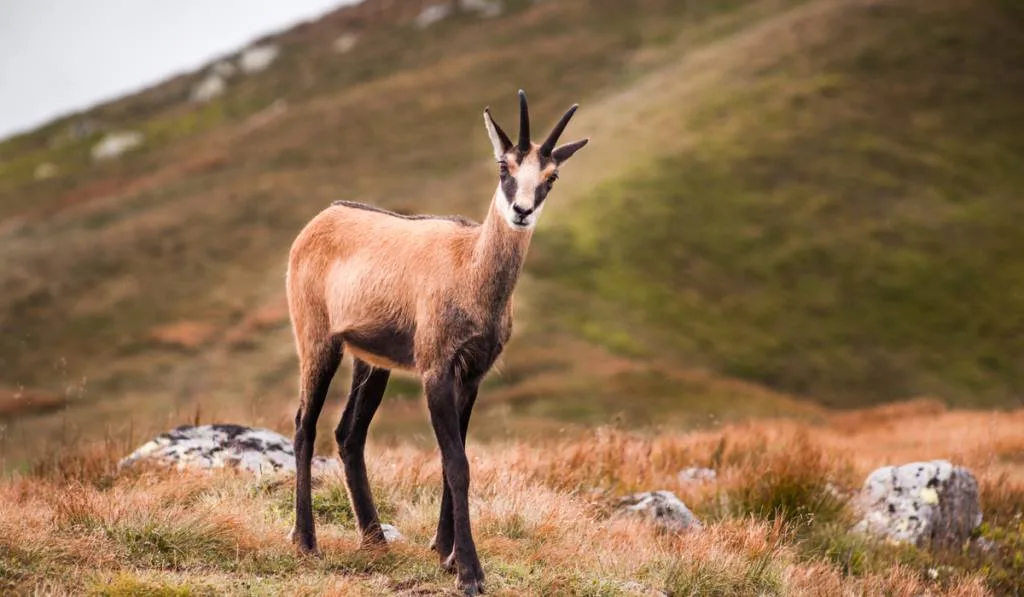
2. Chamois Colored Goat
The Chamois Colored Goat is a breed of Swiss origin which belongs to the Swiss Mountain group of goats.
The Chamois Colored Goat is available in two varieties: the hornless and the horned.
The horned variety is from Grisons, a canton in the eastern part of Switzerland. The hornless Chamois Colored Goat, on the other hand, is from Brienz and Oberhasli in central Switzerland.
Chamois Colored Goats are generally medium-sized.
But relative to other Swiss goats, they are not as long. The bucks are expected to weigh no less than 165 pounds. On the other hand, the does should weigh a minimum of 121 pounds.
The coats of Chamois Colored Goats are brown (chamois) with some black markings on the back, face, belly, and legs.
They may also have some white hair.
Chamois Colored Goats are friendly and gentle.
They tolerate all climates and are good at foraging. While they are typically bred for meat and milk, they may also be kept as pets.
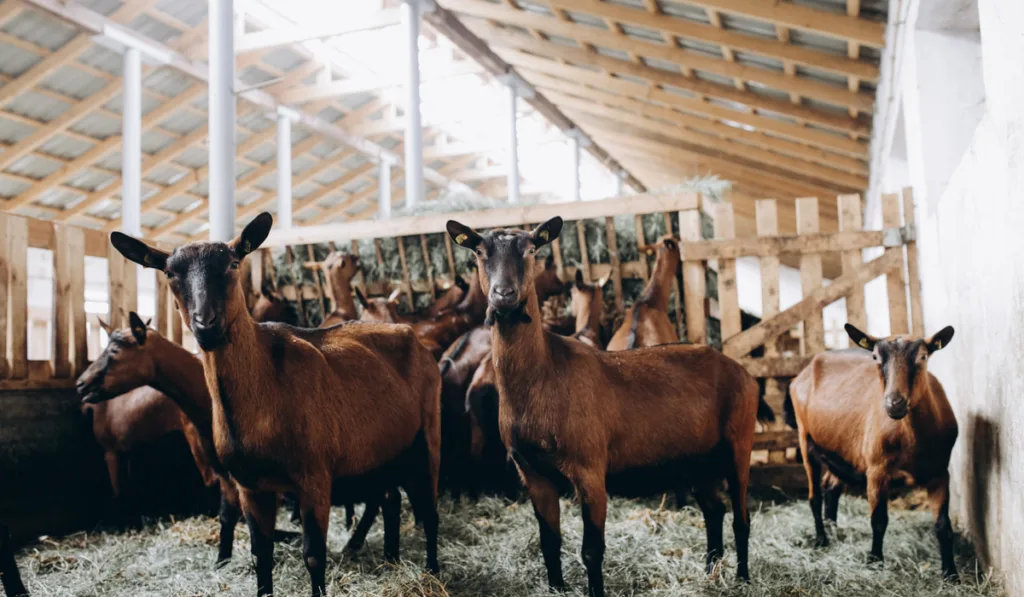
3. Alpine Goat
Alpine Goats are from the famed European mountains, the Alps.
They are medium to large goats and are also known as French Alpines. Alpine does are expected to be at least 30 inches tall while weighing at least 130 pounds.
The bucks should be no less than 34 inches with a weight of at least 135 pounds.
Alpine Goats come in various colors and color patterns. Some of the colors are described in French: chamois and cou noir.
The chamois is a range of different shades of brown, from bay to brown.
Alpine goats are bred for dairy.
They produce large volumes of milk for long periods and the fat and protein content of their milk makes it suitable for the production of cheese.
Due to their curiosity and friendliness, Alpine goats are also kept as companions.
4. Altai Mountain Goat
Altai Mountain Goat is a breed from the Gorno-Altai area of the former Soviet Union.
It is a breed created specifically for the production of wool.
Altai Mountain Goats are medium-sized. The average doe weighs between 90 and 97 pounds, while the bucks weigh 143-154 pounds.
Altai Mountain Goats are adaptable to various climates.
While they are mainly bred for their high-quality wool, they may also be reared for their meat. Their coats are typically black, dark grey, or dark brown.

5. Barbari Goat
The Barbari Goat is of Indian and Pakistan origin, with most of the population being Pakistan.
Goats of this breed are small-sized. The average buck weighs around 83 pounds, while the average doe weighs 50 pounds.
The coat of a Barbari goat is short, and in many cases, it white with brown spotting. But it comes in other solid colors, including brown, creamy, and golden.
Barbari goats are used for 2 primary purposes: milk and meat.
They breed seasonally and are known to attain early maturity and triple kidding.
6. Bionda dell’Adamello
Bionda dell’Adamello, also called Bionda, Adany, or Mustacia, is an Italian goat. The breed is indigenous to Val Camonica, province of Brescia, Italy.
The name of the breed, Bionda dell’Adamello, stems from the color of its hair, boinda – meaning fair, and the name, massif of the Adamello.
This breed has long coats with colors ranging from light brown to blonde.
The distribution of Bionda dell’Adamello is restricted.
The breed is reared mainly in Val Camonica, the mountains of Brescia, and Val Saviore.
Bionda dell’Adamello is a medium to large breed. The average weight of the buck is 154-165 pounds, while that of the doe is 110-132 pounds.
While this breed is kept mainly for milk, it may also be bred for meat and wool.
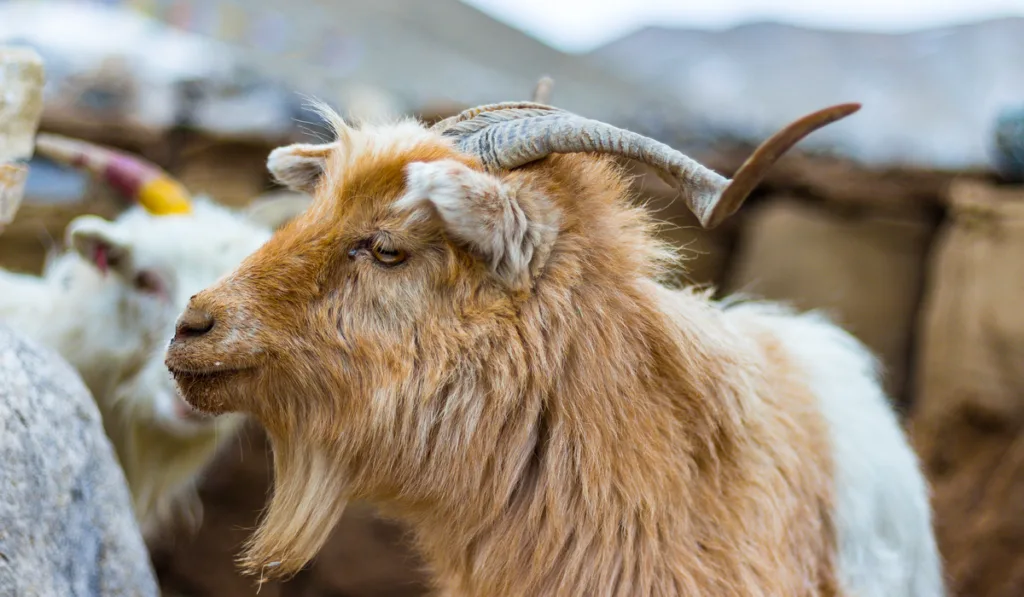
7. Changthangi
Changthangi is a cashmere goat breed. It is native to Kashmir, India, and it may also be called Changra goat or Pashmina goat.
Like other cashmere goats, Changthangis are revered for their soft cashmere wool, called Pashmina – the finest of the cashmere wools.
While it is mainly bred for wool now, in the past, it was also reared for meat.
The coat of a Changthangi can be grey, brown, or black, and it consists of an undercoat – the source of the Pashmina wool.
Changthangi goats are small-sized to medium-sized, with an average buck weighing 68 pounds and an average doe weighing 57 pounds.
Changthangi goats, male or female, have large, twisted horns. But they are not prolific breeders.
In a year, you can expect only one kid from a Changthangi.

8. Toggenburg Goat
Toggenburg goats are common in Australia, but their roots are tied to Obertoggenburg, Switzerland. This breed is the earliest dairy breed recognized in the United States.
Toggenburg goats are medium-sized. Toggenburg does have an average height of 31 inches and an average weight of 121 pounds. On the other hand, the bucks weigh 165 pounds on average while standing at 35 inches.
Their coats are typically fine and short, but some may be long.
The coat colors vary from deep brown to pale brown, and they may have cream or white markings in different parts of their body.
Being dairy goats, Toggenburg goats are mainly bred for their milk.
They typically produce a sustained amount of milk over a long period. Like other goat milk, their milk is whiter and easier to digest than cow milk.
9. Stiefelgeiss
Stiefelgeiss is a domestic goat breed from St. Gallen, Switzerland.
It may also be called Booted goat because its legs (colored black or brown) are darker than the rest of its body.
Besides St. Gallen, Stiefelgeiss may also be found in the canton of Glarus.
Stiefelgeiss are usually bred for meat. But they may also be reared for fiber. Their coats come in various shades of brown, including dark-brown, grey-brown, and dark brown.
The buck and does are horned, and they usually have a long mane called Manteli on their back. The Manteli may either be darker or lighter than the rest of the coat.
Stiefelgeiss goats may also have beards.
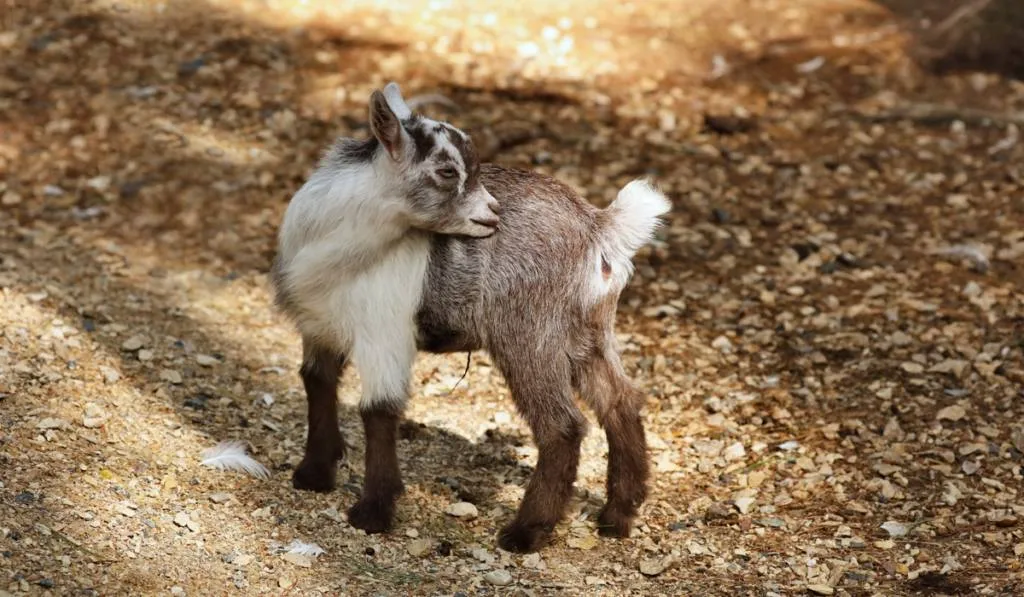
10. American Pygmy Goat
American Pygmy goats are an American goat breed with a lineage traceable to West African Dwarf goats.
Goats of this breed are small-sized. On average, they weigh 50-85 pounds and are as tall as 16-20 inches.
American Pygmy goats come in coats of various colors.
However, only 7 colors are recognized currently. Some of the recognized colors are brown agouti, caramel with brown markings or brown markings, and solid black.
American Pygmy goats may be bred for meat, kept as pets, or kept in a zoo. They also find application in medical research as they are used in the production of antibodies.
Although they are small-sized, Pygmy goats can still produce as much as 1-2 quarts of milk in a day.
Their milk has a significantly high butterfat content. It is topnotch, easy to digest, and whiter than cow milk.
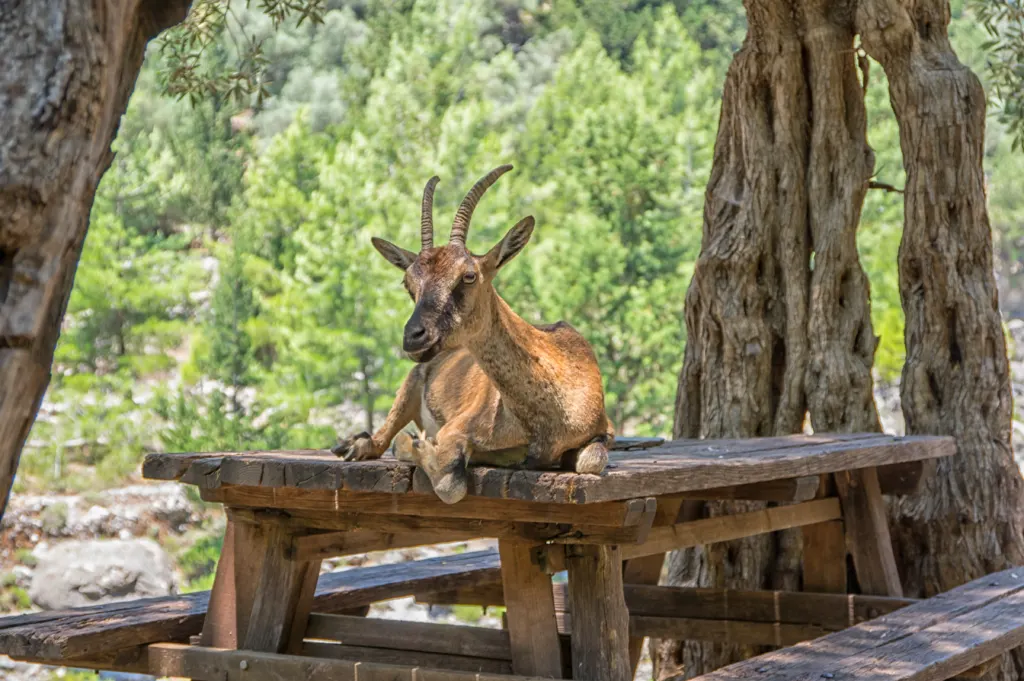
11. Kri-kri
Kri-kri goats are a breed of feral goats typically found in the Eastern Mediterranean. They also go by other names, including Cretan goats, Bezoar goats, Cretan Ibex, and Agrimi.
The population of the Kri-kri goats is currently around 2000, making them a vulnerable breed. The shortage of goats of this breed stems from various factors, including excessive hunting.
But apart from that, diseases, interbreeding, and limited grazing grounds affected their population.
Kri-kri goats come with light-brown coats.
They are small to medium-sized, and the bucks weigh around 198 pounds. The does weigh 57-92 pounds.
Kri-kri goats are great at climbing. They are highly hardy and can tolerate various climates. But they are shy, and they typically spend the day resting.
Resources
- https://petkeen.com/goat-colors-markings-patterns/
- http://afs.okstate.edu/breeds/goats/nigeriandwarf
- https://culturecheesemag.com/farm-animal/nigerian-dwarf-goat/
- https://goats.extension.org/goat-breeds-nigerian-dwarf/
- https://www.wideopenpets.com/all-you-need-to-know-about-the-nigerian-dwarf-goat
- https://www.roysfarm.com/chamois-colored-goat/
- https://www.hobbyfarms.com/alpine-2/
- https://goats.extension.org/goat-breeds-alpine/
- https://www.roysfarm.com/altai-mountain-goat/
- http://www.fao.org/docrep/
- https://books.google.it/books
- http://afs.okstate.edu/breeds/goats/barbari/index.html/
- https://www.roysfarm.com/bionda-delladamello-goat/
- https://www.roysfarm.com/changthangi-goat/
- https://www.britannica.com/animal/Toggenburg-breed-of-goat
- https://www.dpi.nsw.gov.au/animals-and-livestock/goats/breeds/toggenburg
- https://www.fondazioneslowfood.com/en/ark-of-taste-slow-food/stiefelgeiss/
- https://www.roysfarm.com/stiefelgeiss-goat/
- https://www.npga-pygmy.com/resources/conformation/BREED
- http://www.fao.org/dad-is/browse-by-country-and-species/en/
- https://books.google.it/books
- https://www.motherearthnews.com/homesteading-and-livestock/pygmy-goats-for-small-farms-zbcz2012
- https://www.roysfarm.com/kri-kri-goat/
